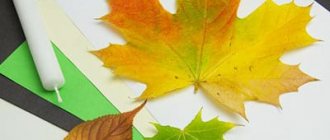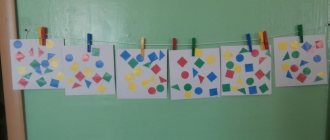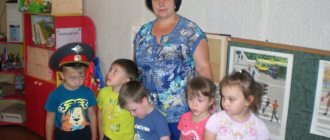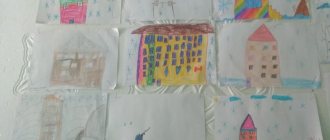Summary of GCD in the middle group for familiarization with the social world on a winter theme
Lesson in the middle group of a preschool educational institution on the topic: “We have begun to dress warmer”
Author: Tatyana Aleksandrovna Koryakina, teacher of the Municipal Preschool Educational Institution “Kindergarten No. 9 KV”, Bogoroditsk Announcement: I bring to your attention a summary of a lesson on cognitive development, which is designed for the middle age group ( children 4-5 years old).
This summary will be useful to teachers of the middle group. By introducing additional didactic exercises and games, the notes can be adapted for the older age group. The abstract combines the integration of such educational areas as cognitive development - familiarization with the natural world, speech development, artistic and aesthetic development, physical development, social and communicative development. In my work I use this material according to the thematic planning “Winter. Seasonal changes in children's clothing." Summary of educational activities in the middle group for familiarization with the social world “We have started to dress warmer”
Organizer: Educator Materials: Model of a snowflake larger than the palm of your hand, visual illustrations of elements of winter clothing, a box with doll clothes of different seasons according to the number of children, coloring pages on the theme of winter clothing (by sheet per child). Program content: Formation of ideas about the relationship between a person’s clothing and the time of year, formation of the ability to name and classify clothes in accordance with the season, development of ideas about the variety of types of clothing, development of fine motor skills of the hands, attentiveness, development of coherent speech, education of a friendly attitude towards nature, education of the ability to interact with children and adults. Preliminary work: game “Dressing the doll Dasha for a walk” Progress of the lesson: Surprise moment “Magic snowflake”. The teacher calls the children to come into his circle. Teacher: Guys, this morning, when I was going to the garden, such a wonderful snowflake fell right on my shoulder (shows hands to the children)
.
Look, it didn't melt in the room, unlike an ordinary snowflake, so it's magical, and we'll leave it in our group. Guys, tell me what a snowflake feels like to the touch? Children: Cold, melts in your hands. Educator: Yes, indeed, a snowflake is a frozen drop of water. What can we do to prevent our hands from freezing? Children: Put on mittens! Educator: Let's imagine magic mittens (asks several children to describe the presented mittens - color, pattern, stripe)
.
Now let's put on our mittens! The mittens are new, (Clench and unclench fingers) Warm, downy. (Rub your cheeks with your hands) My grandmother knitted them for me, (Make a movement as if knitting) She gave them to me and said: “Now my granddaughter (Close and unclench her fingers) won’t have cold hands.” Educator: We put on the mittens, now we need to play with our magic snowflake so that she doesn’t miss her snowflake sisters! Low mobility game “Take care of your hands” Children are in a circle, you need to quickly pass the snowflake to the next one so as not to freeze your fingers. Educator: Well done guys, no one got frostbitten fingers? Guys, tell me, what time of year is it? What changes have taken place on the street? Children: Winter. Snow fell and it became cold. Educator: How do we know that it’s cold outside? Children: Cheeks and nose get cold. Educator: Indeed, it has become cold outside, the frost stings your cheeks. What do people wear to stay warm in winter? Children: warm clothes! Educator: What are these clothes called? Children: Winter! Educator: That's right, guys. I will read you riddles, and you will find the answer picture on the board! Not shoes, not boots, But they are also worn by feet. We run in them in winter: In the morning to the garden, then home. (Felt boots. Children must show the picture on the board)
In order not to freeze, Five children are sitting in a knitted stove.
(Mittens)
They will tie it around my neck, and I won’t get sick anymore.
Wrapped in it up to my nose, I am no longer afraid of the frost. (Scarf)
There are trees all covered in snow, a white carpet on the ground.
We will wear this headdress for a walk. (Hat)
In the cold winter I go - I wear that fur outfit.
And believe me, I will never freeze in the cold! (Fur coat) Educator: What great fellows you are, you know all the winter clothes! Do you remember yesterday we were packing the Dasha doll for a walk? Let's take the dolls Vera and Natasha for a walk today, together with the doll Dasha! But they don’t know what clothes to choose for their walk. What do we need to do? Children: Choose winter clothes and dress the dolls. Didactic game “What clothes will we prepare for the street?” The box contains prepared doll clothes for different seasons; children need to take turns choosing clothes for the season from the box and dressing the dolls. The teacher helps dress the dolls if necessary. Educator : (check with the children that the winter clothes have been sorted correctly)
Here, the dolls Vera and Natasha can go for a walk with Dasha!
Well done! Now the dolls will definitely not freeze! Guys, pay attention to our tables, while you were preparing the dolls for a walk, the magical snowflake prepared another task for you! Go to your seats. Educator: It turns out that our snowflake misses her sisters very much, guys, let's say goodbye to her and let her go! Breathing exercises “Little snowflake” A small snowflake sat on the palm of your hand -
(
Children show the snowflake) I’ll catch it, sit for a while. (Cover one palm with the other) One, two, three, four, five (Slowly open their palms) Let them fly ( Children blow quietly on their palms) Didactic game “Cut pictures. Winter clothes". Educator: Guys, you all did an excellent job. As a reward, the snowflake left you gifts - coloring books and flew back to a magical land!
We recommend watching:
Summary of educational activities for children of the middle group on the topic: Winter Physical education entertainment “Winter-winter” for children of the middle group of preschool educational institutions Summary of educational activities in the middle group on the topic: Winter Summary of organized educational activities with children of the middle group on the topic: Winter
Similar articles:
Observation “Footprints in the snow.” Middle group
Walk observation in winter in the middle group. Winter clothes
Summary of a lesson on socialization for the middle group Topic: “So that the ears can hear”
Summary of a lesson on socialization for the middle group Topic: “So that the ears can hear” Tasks.
Strengthen children's knowledge about vision; introduce children to the structure of the ear and the basic rules of ear care; expand and activate children’s vocabulary on this topic; improve speech in the form of dialogue (when children show a skit); work on the expressiveness of performance; develop memory, auditory attention, speech hearing, hearing acuity.
Material.
Drawn Dunno; illustrations on ear care for each child; objects, toys, screen, scarf for games; poster with pictures; ear diagram.
Progress of the lesson
1. - Guys, we have guests today. And who came with the guests? Of course it's Dunno! Guys, Dunno has friends, and they live in the country of Big Guys. Do you know what kind of country this is? (children's answers) But our Dunno cannot yet live in such a country. Why do you think? (children's answers). Of course, guys, Dunno knows nothing about her body and doesn’t know how to take care of her health. But it seems to me that you and I can help Dunno. Do you agree or not? (children's answers)
2. - Dunno, at the last lesson the guys and I learned that a person’s main assistants are (the eyes). The eyes are an organ of what? (vision). Let's remember and tell Dunno what we can do thanks to vision? (children's answers). What color are Dunno's eyes? (blue). Which part of the eye did you use to determine the color? (by iris)
- Guys, Dunno’s friends gave him this poster with pictures, but he doesn’t know why they gave it to him. Let's look at the poster and try to explain to Dunno. (children talk). This poster and pictures tell Dunno that she needs to protect her eyesight. With the help of good vision we perceive most of the world around us. Don't forget about this poster and take care of your eyesight!
3. - And now you and I will play again and recognize other human helpers.
- And you, Dunno, watch carefully what the children will do, listen and remember what they will talk about.
Game “Name it, don’t make a mistake”
- I will come up to you and touch different parts of the body, whoever correctly names the body part and quantity will sit on a chair.
Game “Recognize an object by sound”
- Here is a screen, objects are hidden behind it. We will recognize them by their sounds. It should be quiet - quiet in order to better hear and determine what object the sound relates to.
- Whoever guesses, clasp your hands. (You can call several children to tell the teacher quietly whose sound they heard).
Game "Guess whose voice?"
“I walk around the house
And I look out the windows. I’ll go up to one and quietly call. Guess the riddle, find out who called you!”
- How did you recognize the children’s voices, what object does the sound relate to? (we heard). What helped you find out? (ears). The ears are the organ of hearing. (children repeat)
“You listened, you heard, and your hearing helped you!”
- What benefit does hearing bring to a person, what sounds does hearing help to hear? (for example, at home, on the street...)
- Yes, guys, with the help of hearing a person hears all the sounds that fill our world (surrounding)
- And it is especially important for a person to hear other people’s speech. After all, with the help of words we communicate with each other, convey our thoughts and knowledge.
Physical exercise.
4. - And this is how it turns out that a person hears. How our ear works. We'll get to know each other now and take a look.
— The visible part of the hearing organ is the external auricle. It determines where, i.e. from which direction the sound or sounds are coming. Next, auditory signals enter the external auditory canal. The pinna and auditory canal form the outer ear. Next, the signals enter the middle ear, which consists of the eardrum - a dense, leathery membrane - and three bones. The sounds then travel to the inner ear. From the inner ear, signals travel to the nerves and then to the brain. There the signals are transformed into words and sounds understandable to humans.
— Guys, there are many points on the auricle that are connected by invisible threads to all our organs (heart, liver, stomach, etc.).
- Therefore, it is good to do self-massage of the ears. You and I know how to do it, let’s teach Dunno.
Wellness moment. (self-massage of ears)
“I will save my health, I will help myself.”
5. — The organ of hearing is the ears. With the help of our ears, we distinguish the voices of animals, the sound of rain, the babbling of a stream, music and human speech.
- Plug your ears with cotton wool. What happened? (children's answers). All sounds immediately disappeared, you stopped hearing.
— To keep your ears from hurting and your hearing to always remain good, you need to know and follow the basic rules. What are these rules? Now, looking at the pictures, tell me yourself.
Protect your ears from cold and strong winds;
Protect ears from noise;
Do not pick your ears;
Avoid getting water into your ears;
Do not blow your nose too much;
If your ears hurt, consult a doctor!
- And also, guys, in order to have good hearing, you need to be able to clean your ears properly. Now go to this table and select those objects with which you can clean your ears (children explain).
“If you guys take care of your ears properly, then you won’t have to see a doctor.”
6. — Guys, your hearing picks up loud sounds, quiet, calm speech, but can your hearing pick up whispers? Dunno and I will now check the acuity of your hearing.
Game "Deaf Phone"
(words: toy, mouse:)
- Well done guys, your hearing is good. Really, Dunno? (yes) Hearing is of great value to a person. Don't forget and take care of him!!!
7. — Guys, besides humans, who else has a hearing organ? (in animals) Why do animals need good hearing? Ears help animals catch prey, escape from enemies, and find each other. Do you know which animal has good hearing? (children's answers). Of course, it is known that animals with large ears hear better. (Hare, deer, elk, roe deer)
“You see how important it is to have good hearing not only for humans, but also for animals.
- Now tell me, what kind of human assistants did we meet? (vision and hearing)
- Right. Dunno, in the next lesson the children and I will continue to get acquainted with our body. We invite you too.




